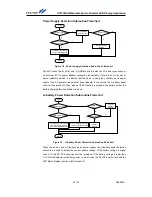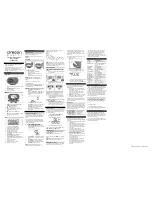
HT1635A/B Wearable Sports Bracelet LED Display Application
3 / 19
AN0393E
COM Driving Methods
Each HT1635A/HT1635B COM pin has two driving types, NMOS open-drain and PMOS
open-drain. No matter what driving type is selected for the COM pins, the ROW pins only
output the data in the corresponding RAM Display Memory. If the RAM is written with a
“1”, its corresponding ROW pin will output a high level, similarly, a “0” value corresponds
to a low level output. The COM driving setup for the two communication interfaces are
shown below.
Communication
Interface
COM Driving
Method
ID
Command Code
Default Setup
4-wire
NMOS driving
1 0 0
0010-0XXX-X
0010-0XXX-X
(NMOS driving)
PMOS driving
0010-1XXX-X
I
2
C
NMOS driving
10001000
XXXXXXX0
00H
(NMOS driving)
PMOS driving
XXXXXXX1
Note: “X”: 0 or 1
Operating Modes
The HT1635A/HT1635B devices support three operating modes, Master Mode0, Master
Mode1 and Slave Mode. With regard to Master Mode0 and Master Mode1, the system
clock can be sourced from the integrated 256 kHz RC oscillator or from the external clock
on the OSC pin, as shown in the following table.
Name
Master/Slave
Select
Input Clock
Source
OSC Pin
Status
SYNC Pin
Status
Note
RC Master
Mode0
Master Mode
On Chip RC
Oscillator
Output Hi-Z
Always
Output High
Only Single Chip
Application
RC Master
Mode1
Output
Output
–
EXT CLK
Master Mode0
Master Mode External OSC
Input
Always
Output High
Only Single Chip
Application
EXT CLK
Master Mode1
Input
Output
–
Slave Mode
Slave Mode External OSC
Input
Input
–
The HT1635A/HT1635B SYNC pin is used for LED driving waveform synchronisation
allowing the cascading of more HT1635 devices to drive a larger screen. Regarding the
HT1635A, which has a 4-wire interface, users can make one device operate in the Master
Mode1 and the remaining devices operate in the Slave Mode. Connect the OSC and
SYNC pins of the Master Mode1 device to the corresponding pins on the Slave Mode
devices. Use the host MCU to control the CSB pin on each HT1635A device to achieve
cascade driving. With respect to the HT1635B, which has an I
2
C interface, the A0 and A1
pins can be configured as pull-high or pull-low to setup the I
2
C slave device address. A
four devices cascade function is available.




















